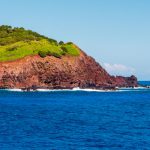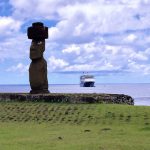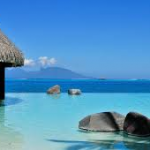As part of Holland America’s 2019 Grand World Voyage of the Amsterdam, our fifth World Cruise, my husband Humberto and I sailed to the San Blas Islands of Panama, Easter Island and two gems of French Polynesia. It was memorable, mainly because of the three M’s: molas, moai, motus.
Molas of the Panamanian San Blas Islands
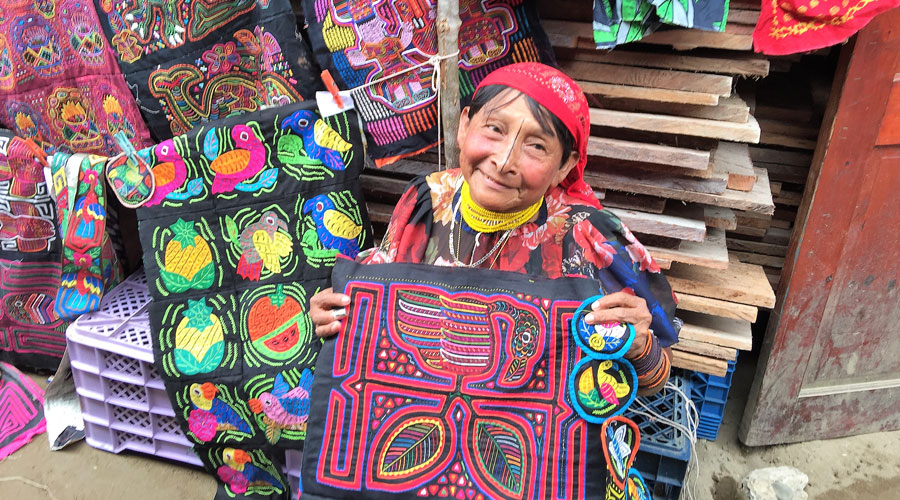
The San Blas Islands is an archipelago consisting of 378 islands scattered around in an area of 100 square miles in the northwest of Panama facing the Caribbean Sea. Many of the San Blas Islands are uninhabited, with some of the larger ones being inhabited by the Guna Indians.
The Amsterdam stopped at a village on the island of Carti, and tenders brought us ashore to explore the village and meet the Islanders. Many of the village women, dressed in traditional clothing and wearing gold jewelry, displayed their molas outside their houses. Molas are colorful, reverse appliqué several-layer cloths, a precious local craft, with handiwork depicting birds, snakes, fish and other local animals as well as abstract designs. Their bright tones, ranging from red to orange as well as black and other colors, were beautiful.
Some molas were incorporated into bags, blouses, and dresses to create eye-catching, wearable art. Others were loose rectangles and squares of cloth, suitable for framing or for sewing on to apparel and bags. After exploring the village, we talked to some of the islanders, many of whom speak some English and Spanish, as the islands are an autonomous region of Spanish-speaking Panama. We purchased a couple of molas as they will always remind us fondly of our journey.
The Moai of Easter Island
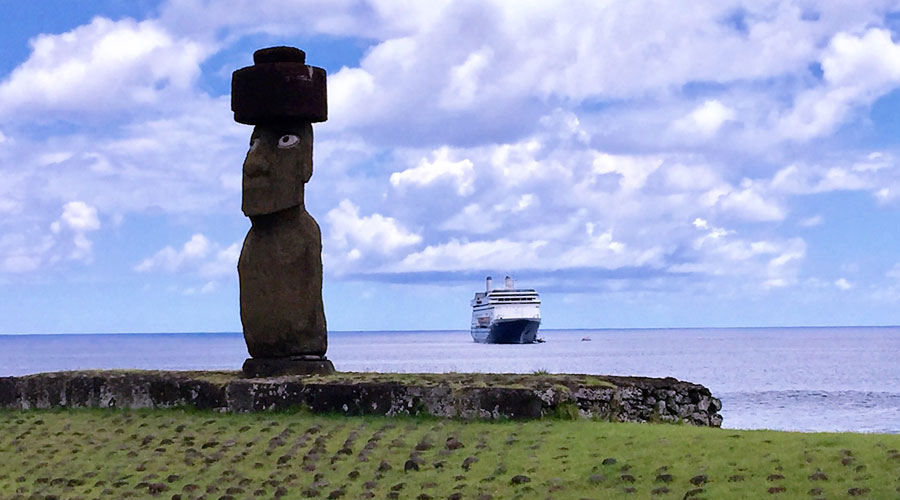
Moai are the enigmatic sculptures of Easter Island, a 63-square mile speck of land in the middle of the Pacific Ocean—a Holy Grail among veteran travelers as one of the most isolated and mysterious spots on the planet.
Those who have studied Easter Island estimate Polynesians settled between 800 to 1200 A.D. and created the monumental, world-famous Polynesian moai sculptures between 800 and 1600 A.D. to honor ancestors. The island was first seen by Europeans in 1722 when Dutch navigator Jacob Roggeveen came upon it. It was annexed by Chile in the 19th century and called Isla de Pascua or Easter Island. Rapa Nui is its Polynesian name.
Most of Easter Island is national parkland and a UNESCO World Heritage Site with nearly 1,000 moai. These are monolithic statues carved from the volcanic rock tuff and are commonly referred to as Heads or Big Heads. The statues do have large heads—they have a 3:5 ratio between the head and the trunk—but the name Big Heads may come from the fact that some of the statues are half-buried by years of exposure to the elements, thus looking like big heads sitting on top of the ground. However, the rest of the bodies are underground. Characteristics of the statues include heavy brows, elongated noses and lips that protrude in a thin pout.
Mysticism is associated with the statues. Our local guide told us that the statues acted as antennas. Placed over graves of distinguished ancestors believed to possess manna, a supernatural quality that protects people, the antennae beamed the manna from the ancestors back to the living through their eyes. We toured the ceremonial site of Tahai in the town of Hanga Roa, where statues are displayed on altar-like platforms called ahu, including one statue with decorative eyes. The eyes, made of shell and stone, may have been inserted only for special occasions for fear that the eyes would be stolen if permanently left on the statues.
We also toured Ahu Tongariki, the largest ceremonial center of the island with 15 moai and Rano Raraku, the volcano that was turned into the main quarry for the statues. The quarry has about 400 moai scattered around including the largest of the island. Of the 400 statues, about half are finished and the rest were never completed. Among the unfinished statues is one towering at 71 feet and estimated to weigh 200 tons.
Scientists have yet to solve many of the puzzles surrounding the statues, including how these heavy works of art—some weighing as much as 82 tons—were moved to their present positions by a Stone Age culture. Theories include that the moai were rolled into place on tree trunks, that the statues were beamed into place by extraterrestrials, and that the statues walked to their positions!
French Polynesia’s Motus

One of the most iconic sights of French Polynesia is that of a pure white-sand-ringed motu or islet, verdant with vegetation and surrounded by aquamarine lagoons. We were enchanted to see a number of these motus during a shore excursion on the yacht of the Four Seasons Bora Bora. The resort is located on a motu and boasts views of Bora Bora’s imposing Mt. Otemanu. Its crystal-clear lagoon is perfect for snorkeling. There were many opportunities to see neon-colored tropical fish including angelfish and parrotfish, corals, rays, sea turtles and even reef sharks.
Pastimes at the resort include kayaking and standup paddleboarding. There is a spa where guests can enjoy pampering treatments and a chapel where lovebirds can tie the knot or renew their wedding vows. Dining at the Sunset Restaurant & Bar and other resort restaurants offer opportunities to feast on sushi, fresh fish and tropical fruit platters with succulent mangoes, pineapples and papayas.
In addition to Bora Bora, the Amsterdam’s World Cruise called at Papeete, the capital of French Polynesia. We shopped for crafts and monoi oil—a perfumed oil made from soaking gardenias in coconut oil—in the municipal market of Tahiti. We also explored the InterContinental Tahiti Resort & Spa, a 15-minute taxi ride from the cruise pier. On the grounds of the InterContinental Tahiti are 30 acres of gardens and private beach. It features a diving center and a Lagoonarium where visitors can learn about corals, shells and sea creatures. There’s also an outdoor pool, a spa and fitness center, tennis courts, restaurants and a Polynesian Revue. Papeete’s museums, shops, galleries, market, and nightclubs are a short drive away from the resort. Additionally, Le Lotus Restaurant serves French-accented fare in a secluded spot of the resort for a private dinner to yourself or with your loved one.
